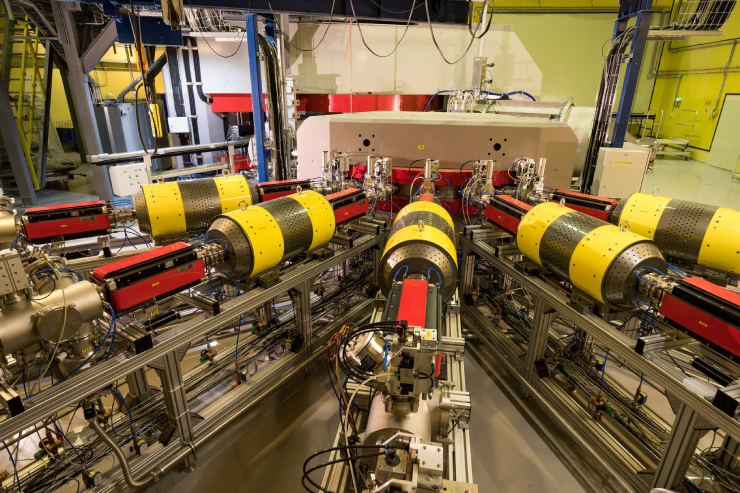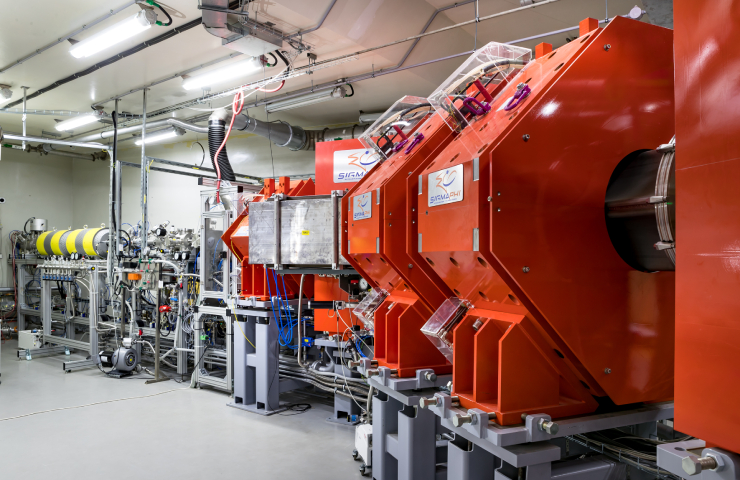Superheavy Element Factory: overview of obtained results
News, 24 August 2023
The authors of a series of works “The Factory of Superheavy Elements: first results” were awarded the First JINR Prize 2022 in the category “Experimental Research” for achievements in 2022: Yuri Oganessian, Sergey Dmitriev, Farid Abdullin, Dastan Ibadullayev, Alexander Polyakov, Roman Sagaidak, Vladimir Utyonkov, Yuri Tsyganov, Maksim Shumeiko, and Nikita Kovrizhnykh. The Head of the Sector of the Synthesis and Properties of Superheavy Nuclei of JINR’s Flerov Laboratory of Nuclear Reactions Vladimir Utenkov gave a talk about the conducted work. Over the past few years, the scientists have demonstrated world-class results. The researchers conducted a series of experiments that resulted in the synthesis of the new isotopes 286Mc, 275Ds, 276Ds, 272Hs, 268Sg, and 264Lr. The 268Db decay properties were determined for the first time. New decay properties of the known nuclei were found.
A region of superheavy elements predicted around 60 years ago was discovered in the Flerov Laboratory of Nuclear Reactions back in 1999. Numerous experiments carried out in laboratories worldwide did not bear fruit. JINR researchers managed to increase experimental sensitivity as compared to that attained earlier, which led to the discovery of six new elements—113 through 118—and the synthesis of over 50 new isotopes of elements from 104 to 118. These experiments were conducted at the U-400 accelerator and the DGFRS separator whose sensitivity was considered record-breaking at the time, though insufficient for synthesizing new elements heavier than 118. The required experimental parameters were attained owing to the commissioning of the Superheavy Element Factory complex over three years ago.
“Experiments conducted at the Superheavy Element Factory were aimed at testing the potential of the complex whose key elements are the new DC-280 accelerator capable of runnning experiments at record beam intensities—nearly an order of magnitude higher than those at existing facilities worldwide—and the new DGFRS-2 separator,” Head of the FLNR Sector of the Synthesis and Properties of Superheavy Nuclei Vladimir Utenkov said. “Experiments allowed us to thoroughly examine the characteristics of the new separator and revealed the unique capabilities of the Factory in synthesizing new elements”.
 At the ‘heart’ of the Factory is the DC-280 cyclotron
At the ‘heart’ of the Factory is the DC-280 cyclotron
The scientist noted that the new separator’s collection efficiency of nuclei at detectors is twice that of DGFRS. “The collection efficiency of similar separators in labs worldwide is comparable to that of DGFRS-2 but the suppression of background reaction products, hampering experiments and destroying detectors, is record high at the new separator: two orders of magnitude (100 times) higher than that at DGFRS and significantly higher than that provided by other separators,” noted Vladimir Utenkov.
Experiments aimed at studying the 243Am+48Cа reaction were conducted at six projectile energies. One hundred twenty-five decay chains of Mc isotopes were registered, which is over three times greater than those registered in previous experiments at DGFRS in 2003–2012. Compared to the results of previous experiments, the efficiency of collecting nuclei by the detectors of the new separator is twice the transmission of DGFRS, which is of utmost importance in setting up experiments aimed at synthesizing new superheavy elements heavier than Og (Z=118).
A new and the lightest isotope 286Мс was synthesized for the first time. Its decay properties are essential for the identification of new element 119, a product of the 243Am(54Cr,3n)294119 reaction, by correlations with the known nuclei and cross reactions.
The cross section for the 5n-evaporation channel for the 243Am+48Cа reaction was measured. It should be noted that in previous studies, the channel with the evaporation of five neutrons was observed only in reactions with even-Z target nuclei, and the products of the channel were detected only in two chains – in the reactions with 244Pu and 242Pu. A maximum cross section of the 243Am(48Ca,3n)288Mc reaction was 17 pb (1 pb = 10-36 cm2), which is twice as high as those measured in earlier studies and is the largest of all known cross sections for superheavy nuclei.
The decay properties of 21 isotopes of superheavy elements Mc through Db were determined and measured with higher precision. In experiments carried out earlier in FLNR (DGFRS) and subsequently in GSI (Helmholtz Centre for Heavy-Ion Research, Darmstadt) at TASCA and in LBNL (Lawrence Berkeley National Laboratory) at BGS, 268Db (half-life of approximately 1 day) was observed to undergo only spontaneous fission. The long lifetime and the increased background of alpha-like events did not allow for the detection of its possible alpha-decay. Owing to higher background suppression at DGFRS-2 (by two orders of magnitude), an alpha decay of 268Db with a probability of 50% was detected for the first time, leading to the discovery of a new spontaneously fissioning 264Lr. Inasmuch as the half-life of 268Db was previously estimated from the decay chains of 288Mc followed by spontaneous fission that may originate from both 268Db and 264Lr, one can conclude that the radioactive properties of 268Db were defined for the first time, too.
In one of the decay chains of 287Mc, a spontaneous fission branch for 279Rg was observed for the first time, thereby allowing the researchers to determine its stability against fission.
Thereto a series of experiments were conducted on the study of the isotopes of even-Z elements in the 242Pu+48Ca and 238U+48Ca reactions. Sixteen decay chains of 283Cn (Z=112) and its daughter nuclei up to 267Rf (Z=104) were registered in the 238U+48Ca reaction at two projectile energies near the Coulomb barrier. The maximum beam intensity of 48Ca was 6.5 рµА, which is six times higher than the capacity of existing accelerators.
The very same isotope was observed as a daughter nucleus after the alpha decay of 287Fl in the 242Pu(48Ca,3n)287Fl reaction. Sixty-nine new decay chains of 287Fl were detected. It is to be noted that most of the decay chains terminated by spontaneous fission of 279Ds (Z=110). In previous studies, only four decay chains were observed in which 279Ds underwent alpha decay. In experiments at DGFRS-2, 11 new alpha decays of 279Ds were detected, which allowed one to determine the properties of the daughter nuclei 275Hs, 271Sg, and 267Rf with greater accuracy.
The results also point to the decays of 287Fl, 283Cn, and 279Ds through various energy levels, leading to the alpha decay of 279Ds in one case and its spontaneous fission in another, which was not observed in nuclei of superheavy elements. A similar feature was earlier observed only in two light nuclei – 261Rf and 247Md. A substantial increase in the number of registered nuclei led to a more accurate measurement of the cross section for the 242Pu(48Ca,3n)287Fl reaction, which turned out to be larger than the previous result by a factor of three.
Twenty-five decay chains of the even-even isotope 286Fl were synthesized in another channel of the 242Pu(48Ca,4n)286Fl reaction, which undergoes alpha-decay and spontaneous fission with rougly equal probabilities. The new data allowed for two important conclusions. First, the experimental results obtained at TASCA (GSI) were brought into question: in one of the two detected decay chains of 286Fl, a decay to the high-energy level of the daughter nucleus was supposedly observed. This may point to the deformation of the nuclei under interest, which is in contradiction with conventional theoretical calculations. The number of 286Fl nuclei not undergoing such decay exceeded that in the aforementioned work by an order of magnitude. On the other hand, an additional line with an energy 100–200 keV lower than that of the main peak was observed for the first time for the even-even superheavy nucleus. A possible origin of this line is the decay from the ground state 286Fl (0+) to the first rotational 2+ state of 282Cn.
This assumption agrees well with the energy calculations for the 2+ level. Precise measurements of the level energy will subsequently allow the estimation of the deformation of the superheavy nucleus.
Quite as interesting is another explanation of the nature of the observed line, which is based on predicted isomeric states. According to calculations, the difference in the energy may be caused by population in the reaction of a two-quasiproton isomeric state
5π+ in 286Fl and subsequent decay to the same level 5π+ in 282Cn. Such exotic decays have never been observed in superheavy nuclei either. In these experiments, the decay properties of 8 isotopes of elements Rf through Fl were determined more accurately.Experiments on the synthesis of Ds isotopes in the 232Th+48Ca reaction were conducted, too. Their properties are essential for the identification of new element 120 in the 249Cf+50Ti and 245Cm+54Cr reactions because the alpha decays of the 295,296120 nuclei lead to the isotopes 275,276Ds, and for predictions of the production cross sections for the isotopes of element 120. Six decay chains of the new isotope 276Ds were synthesized for the first time, whose alpha decay led to the discovery of two other isotopes, 272Hs and 268Sg. In one of these experiments, the reaction cross section was 0.07 pb, which is in line with the expected production cross section of new elements 119 and 120. Furthermore, a new isotope 276Ds was synthesized. The alpha decay of this nucleus led to the isotopes 271Hs, 267Sg, and 263Rf that were previously synthesized in the 248Cm(26Mg,3n)271Hs reaction. Thus alpha decay was observed for the first time from the region of superheavy nuclei, produced in 48Са-induced reactions, toward the region of the known nuclei. This once more confirmed the validity of the the results on the synthesis of superheavy elements.
The results obtained at the Superheavy Element Factory demonstrated high sensitivity of the facility required for further studies of the region of superheavy elements and synthesis of new elements 119 and 120.
This studies were partially supported by the grant of the Ministry of Science and Higher Education of Russia “Superheavy nuclei and atoms: mass limits of nuclei and boundaries of the Periodic Table”.
List of publications:
- Yu.Ts. Oganessian, V.K. Utyonkov, D. Ibadullayev, F.Sh. Abdullin, S.N. Dmitriev, M.G. Itkis,A.V. Karpov, N.D. Kovrizhnykh, D.A. Kuznetsov, O.V. Petrushkin, A.V. Podshibiakin,A.N. Polyakov, A.G. Popeko, R.N. Sagaidak, L. Schlattauer, V.D. Shubin, M.V. Shumeiko,D.I. Solovyev, Yu.S. Tsyganov, A.A. Voinov, V.G. Subbotin, A.Yu. Bodrov, A.V. Sabel’nikov,A. Lindner, K.P. Rykaczewski, T.T. King, J.B. Roberto, N.T. Brewer, R.K. Grzywacz, Z.G. Gan,Z.Y. Zhang, M.H. Huang, and H.B. Yang. Investigation of 48Ca-induced reactions with 242Pu and 238U targets at the JINR Superheavy Element Factory. Phys. Rev. C 106, 026412 (2022).
- Yu. Ts. Oganessian, V. K. Utyonkov, N. D. Kovrizhnykh, F. Sh. Abdullin, S. N. Dmitriev, D.Ibadullayev, M. G. Itkis, D. A. Kuznetsov, O. V. Petrushkin, A. V. Podshibiakin, A. N. Polyakov,A. G. Popeko, R. N. Sagaidak, L. Schlattauer, I. V. Shirokovski, V. D. Shubin, M. V. Shumeiko, D.I. Solovyev, Yu. S. Tsyganov, A. A. Voinov, V. G. Subbotin, A. Yu. Bodrov, A. V. Sabel’nikov, A. V. Khalkin, V. B. Zlokazov, K. P. Rykaczewski, T. T. King, J. B. Roberto, N. T. Brewer, R. K. Grzywacz, Z. G. Gan, Z. Y. Zhang, M. H. Huang, and H. B. Yang. First experiment at the Super Heavy Element Factory: High cross section of 288Mc in the 243Am+48Ca reaction and identification of the new isotope 264Lr. Phys. Rev. C 106, L031301 (2022).
- Н.Д. Коврижных, Ю.Ц. Оганесян, В.К. Утенков, Ф.Ш. Абдуллин, С.Н. Дмитриев, А.А. Джиоев, Д. Ибадуллаев, М.Г. Иткис, А.В. Карпов, Д.А. Кузнецов, О.В. Петрушкин, А.В. Подшибякин, А.Н. Поляков, А.Г. Попеко, И.С. Рогов, Р.Н. Сагайдак, Л. Шлаттауэр, И.В. Широковский, В.Д. Шубин, М.В. Шумейко, Д.И. Соловьев, Ю.С. Цыганов, А.А. Воинов, В.Г. Субботин, А.Ю. Бодров, А.В. Сабельников, А.В. Халкин, В.Б. Злоказов, К.П. Рикачевски, Т.Т.Кинг, Дж.Б. Роберто, Н.Т.Брюэр, Р.К. Грживач, З.Г. Ган, З.Я.Чжан, М.Х. Хуан, Х.Б. Ян. Первый эксперимент на Фабрике Сверхтяжелых Элементов: новые данные в реакции 243Am + 48Ca. Доклад на LXXII Международной конференции «Ядро-2022: Фундаментальные вопросы и приложения». Вестник РАН. Серия Физическая (принято в печать).
- Д. Ибадуллаев, В. К. Утенков, Ю. Ц. Оганесян, Ф.Ш. Абдуллин С.Н. Дмитриев, М.Г.Иткис, А.В. Карпов, Н.Д. Коврижных, Д.А. Кузнецов, О.В. Петрушкин, А.В. Подшибякин,А.Н. Поляков, А.Г. Попеко, Р.Н. Сагайдак, Л. Шлаттауэр, В.Д. Шубин, М.В. Шумейко, Д.И.Соловьев, Ю.С. Цыганов, А.А. Воинов, В.Г. Субботин, А.Ю. Бодров, А.В. Сабельников, A.Линднер, K.П. Рикашевски, T.T. Кинг, Дж.Б. Роберто, Н.T. Брюуэр, Р.K. Гживатч, З.Г. Ган,З.И. Жан, M.Х. Хуан, Х.Б. Ян, Ш.Г. Гиниятова. Исследование реакции 242Pu + 48Ca на Фабрике Сверхтяжелых Элементов. Доклад на LXXII Международной конференции «Ядро-2022: Фундаментальные вопросы и приложения». Вестник РАН. Серия Физическая (принято в печать).
- Yu. Ts. Oganessian, V. K. Utyonkov, N. D. Kovrizhnykh, F. Sh. Abdullin, S. N. Dmitriev, A. A. Dzhioev, D. Ibadullayev, M. G. Itkis, A. V. Karpov, D. A. Kuznetsov, O. V. Petrushkin, A. V. Podshibiakin, A. N. Polyakov, A. G. Popeko, I. S. Rogov, R. N. Sagaidak, L. Schlattauer, V. D. Shubin, M. V. Shumeiko, D. I. Solovyev, Yu. S. Tsyganov, A. A. Voinov, V. G. Subbotin, A. Yu. Bodrov, A. V. Sabel’nikov, A. V. Khalkin, K. P. Rykaczewski, T. T. King, J. B. Roberto, N. T. Brewer, R. K. Grzywacz, Z. G. Gan, Z. Y. Zhang, M. H. Huang, and H. B. Yang. New isotope 286Mc produced in the 243Am + 48Ca reaction. Phys. Rev. C 106, 064306 (2022).
- Yu. Ts. Oganessian, V. K. Utyonkov, M. V. Shumeiko, F. Sh. Abdullin, S. N. Dmitriev, D. Ibadullayev, M. G. Itkis, N. D. Kovrizhnykh, D. A. Kuznetsov, O. V. Petrushkin, A. V. Podshibiakin, A. N. Polyakov, A. G. Popeko, I. S. Rogov, R. N. Sagaidak, L. Schlattauer, V. D. Shubin, D. I. Solovyev, Yu. S. Tsyganov, A. A. Voinov, V. G. Subbotin, N. S. Bublikova, M. G. Voronyuk, A. V. Sabelnikov, A. Yu. Bodrov, Z. G. Gan, Z. Y. Zhang, M. H. Huang, and H. B. Yang. New isotope 276Ds and its decay products 272Hs and 268Sg from the 232Th + 48Ca reaction. Phys. Rev. C (to be published).

